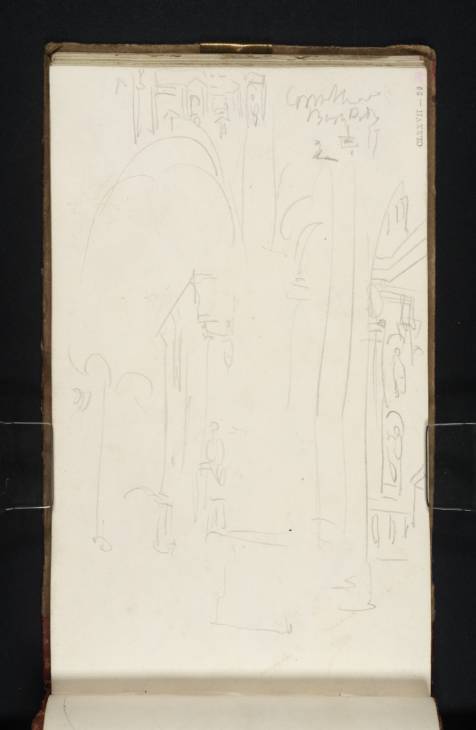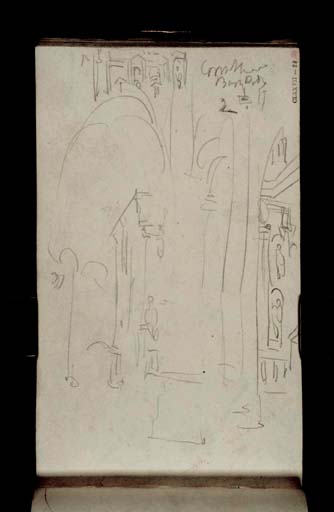Joseph Mallord William Turner The Holy House inside the Santuario della Santa Casa, Loreto 1819
Image 1 of 2
Joseph Mallord William Turner,
The Holy House inside the Santuario della Santa Casa, Loreto
1819
Joseph Mallord William Turner 1775–1851
Folio 29 Recto:
The Holy House inside the Santuario della Santa Casa, Loreto 1819
D14708
Turner Bequest CLXXVII 29
Turner Bequest CLXXVII 29
Pencil on white wove paper, 186 x 110 mm
Inscribed by the artist in pencil ‘Corinthian | B[...] P[...]’ top right
Inscribed by John Ruskin in red ink ‘29’ top right, ascending right-hand edge
Stamped in black ‘CLXXVII 29’ top right, ascending right-hand edge
Inscribed by the artist in pencil ‘Corinthian | B[...] P[...]’ top right
Inscribed by John Ruskin in red ink ‘29’ top right, ascending right-hand edge
Stamped in black ‘CLXXVII 29’ top right, ascending right-hand edge
Accepted by the nation as part of the Turner Bequest 1856
References
1909
A.J. Finberg, A Complete Inventory of the Drawings of the Turner Bequest, London 1909, vol.I, p.521 as ‘A building’.
1984
Cecilia Powell, ‘Turner on Classic Ground: His Visits to Central and Southern Italy and Related Paintings and Drawings’, unpublished Ph.D thesis, Courtauld Institute of Art, University of London 1984, pp.98 and 467 note 125, 409, as ‘The Holy House inside the Santuario della Santa Casa, Loreto’.
1987
Cecilia Powell, Turner in the South: Rome, Naples, Florence, New Haven and London 1987, p.31.
Cecilia Powell has identified the subject of these sketches as the shrine of the Holy House inside the Santuario della Santa Casa at Loreto. The page is not adjacent to other views of Loreto, see folio 10 (D14671) and disrupts the geographical continuity of the sketchbook.
According to legend, the Holy House, the home of the Virgin Mary where she received the annunciation and where Jesus spent his childhood, was transported from Palestine during the thirteenth century by a host of angels and eventually carried to its present site where it came to rest amidst the laurel woods which give Loreto its name. During the eighteenth and nineteenth centuries it was one of the most popular sites for Catholic pilgrimage in Italy after St Peter’s. The house itself is a modest stone and brick vault adorned with frescoes and an altar. The edifice is encased within a marble screen commissioned in 1507 by Pope Julius II and designed by Andrea Sansovino.1 The four sides of the richly decorated screen contain scenes in bas-relief depicting the Annunciation, the Nativity, the Arrival of the Holy House to Loreto and the Nativity of the Virgin, and niches containing statues of the Prophets and Sybils. Corinthian capitals divide the screen into sections and support a projecting cornice and the entire structure is topped by a balustrade. The main drawing on this page depicts one side and end of the marble screen from behind the arches of the apse of the basilica. At the top of the page is a smaller sketch of one complete side of the structure showing the two entrances to the Holy House with their triangular pediments.
In addition to his sketches of Loreto in the Ancona to Rome sketchbook Turner also made a number of small drawings and notes relating to the Santa Casa in his copy of Reichard’s Italy, a guidebook which he carried with him during his 1819 tour (see Tate; Turner Bequest CCCLXVII pp.330 and 378). The annotations appear on the same pages which describe Loreto and Cecilia Powell has identified the tiny sketches as details from the marble screen and the ceramic vases in the pharmacy of the Palazzo Apostolico.2 The latter would have caught Turner’s interest since they are decorated with classical scenes, supposedly after the designs of Raphael and Giulio Romano.
Nicola Moorby
November 2008
How to cite
Nicola Moorby, ‘The Holy House inside the Santuario della Santa Casa, Loreto 1819 by Joseph Mallord William Turner’, catalogue entry, November 2008, in David Blayney Brown (ed.), J.M.W. Turner: Sketchbooks, Drawings and Watercolours, Tate Research Publication, December 2012, https://www


